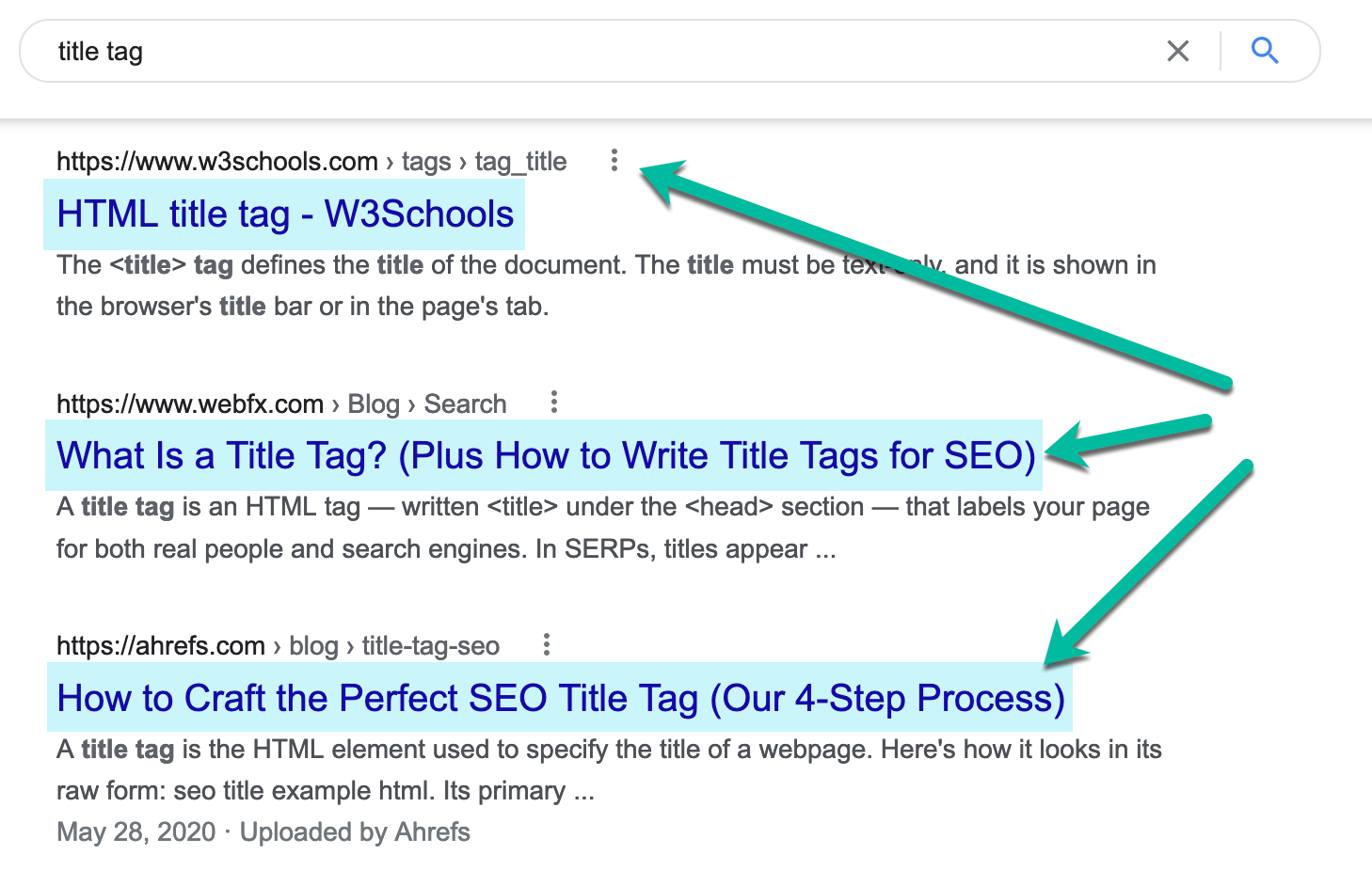
Mastering SEO: The Top 10 Meta Tags You Must Understand
In the world of SEO, meta tags are the unsung heroes. These hidden pieces of code embedded in your website’s HTML structure are like secret messages to search engines, guiding them on how to categorize and display your content. In this article, we’ll delve into the 10 most crucial meta tags you should master for SEO success. We’ll explore each tag in detail, provide examples, and share some SEO-optimized keywords to help you rank higher on Google and drive maximum monthly traffic to your website.
1. Title Tag – Your SEO Headliner
Example:
<title>Unlocking SEO Success: The Power of Meta Tags</title>
Your title tag is like the headline of a newspaper article. It’s the first thing users see in search results and browser tabs. Keep it under 70 characters and include your primary keyword. In our example, “Unlocking SEO Success” is the captivating headline that tells readers what to expect.

The Power of the Title Tag
Why is the Title Tag So Crucial for SEO?
Imagine the Title Tag as the cover of a book. When someone scans a search engine results page (SERP), the Title Tag is the book cover that either entices them to open and read further or keeps them scrolling. Here’s why it’s essential:
First Impressions: | It’s the first thing users see in search results. A well-crafted Title Tag can capture their attention instantly. |
Keyword Placement: | Search engines use the Title Tag to understand the content of your page. It’s a prime location for inserting your target keywords. |
Click-Through Rates (CTR): | A compelling Title Tag can significantly impact your CTR. More clicks mean more traffic. |
Brand Visibility: | For established brands, the Title Tag reinforces brand recognition. For new websites, it’s an opportunity to make a memorable first impression. |

Crafting the Perfect Title Tag
Here’s How to Create an Effective Title Tag:
| Keyword Inclusion: | Include your primary keyword naturally, preferably toward the beginning of the tag. |
| Relevance: | Ensure that the Title Tag accurately represents the content of the page. Misleading titles can harm your SEO. |
| Length: | Keep it concise, typically under 70 characters, to prevent truncation in search results. |
| Engagement: | Make it engaging and intriguing. Pose a question, promise a solution, or evoke curiosity. |
| Brand Mention: | For brand recognition, add your brand name at the end, separated by a pipe or dash. |
2. Meta Description Tag – Your SEO Elevator Pitch
Example:
<meta name="description" content="Learn the art of meta tags and skyrocket your SEO rankings. Discover the secrets to effective SEO optimization." />

Consider the meta description tag your elevator pitch. It’s a brief summary of your page’s content. While it doesn’t directly affect rankings, it entices users to click. In our example, the meta description invites users to “learn the art of meta tags” and promises to reveal “the secrets to effective SEO optimization.”
3. Meta Keywords Tag (Obsolete) – A Relic of the Past
In the early days of SEO, the meta keywords tag held sway. However, search engines have evolved, rendering it obsolete. Focus your efforts on other tags and strategies that matter in the current SEO landscape.
The Rise and Fall of Meta Keywords
What was the Meta Keywords Tag?
In the early days of the internet, webmasters used the Meta Keywords Tag as a way to tell search engines what keywords were relevant to their web pages. This tag allowed them to stuff keywords into their HTML code, hoping to boost their rankings in search results.

Why Was it Popular?
The Meta Keywords Tag gained popularity because it seemed like an easy way to tell search engines what a web page was about. By loading it up with keywords, webmasters believed they could trick search engines into ranking their pages higher.
The Decline of Meta Keywords
As search engines like Google grew smarter, they realized that webmasters were abusing the Meta Keywords Tag. Instead of improving search results, it often led to keyword stuffing and poor-quality content. As a result, search engines started to ignore this tag in their ranking algorithms.
4. Meta Robots Tag – Controlling Crawling and Indexing
Example:
<meta name="robots" content="index, follow" />
The meta robots tag guides search engines on how to crawl and index your page. “Index” allows indexing, while “follow” instructs search engines to follow links on the page. In the example, we’re telling search engines to both index the page and follow its links.

Controlling Crawling and Indexing
Let’s explore the key directives that the Meta Robots Tag can employ to control crawling and indexing:
a. noindex, nofollow
When you employ the noindex, nofollow directive in your Meta Robots Tag, you’re essentially telling search engine crawlers to steer clear of your page. This means your page won’t be indexed, and any links on the page won’t be followed. This directive is particularly useful for pages like privacy policies, terms of service, or internal admin pages that you don’t want to appear in search engine results.
Example:
<meta name="robots" content="noindex, nofollow" />
b. index, follow
On the flip side, using the index, follow directive indicates to search engines that your page should be indexed, and any links within it should be followed. This is the default behavior for most web pages and is ideal for your main content pages that you want to be discoverable in search results.
Example:
<meta name="robots" content="index, follow" />
c. noindex, follow
With this directive, you’re telling search engines to skip indexing your page while still following and indexing any links on the page. It’s a practical choice for pages where you want to pass link juice but keep the page itself out of search results.
Example:
<meta name="robots" content="noindex, follow" />
d. index, nofollow
This directive is a rare combination, as it instructs search engines to index your page but not follow any links within it. It might be useful for specific situations where you want the page itself in search results but don’t want to pass authority to linked pages.
Example:
<meta name="robots" content="index, nofollow" />

Best Practices for Using the Meta Robots Tag
Now that you understand the various directives at your disposal, let’s delve into some best practices for utilizing the Meta Robots Tag effectively:
1. Use Default Behavior | For most of your web pages, you can rely on the default behavior, which is index, follow. This ensures that your content is discoverable and that links on the page are followed. |
2. Be Strategic | Use directives like noindex, nofollow selectively for pages that genuinely need to be hidden from search engines, such as confidential documents or duplicate content that you don’t want indexed. |
3. Regularly Audit Your Tags | As your website evolves, regularly audit your Meta Robots Tags to ensure they align with your SEO goals. Pages that were once relevant may no longer serve the same purpose. |
4. Leverage Robots.txt | In conjunction with the Meta Robots Tag, consider using a robots.txt file to provide additional instructions to search engine crawlers. The robots.txt file can complement the Meta Robots Tag’s directives. |
5. Canonical Tag – Preventing Duplicate Content
Example:
<link rel="canonical" href="https://www.example.com/seo-success" />
Duplicate content can harm your SEO. The canonical tag specifies the preferred version of a page, helping search engines avoid confusion. In our example, it’s clear that we want the “seo-success” page to take precedence.
Why is the Canonical Tag Important?
1. Preventing Duplicate Content:
Duplicate content can confuse search engines, causing them to split ranking signals between multiple URLs. This dilution can harm your SEO efforts. The Canonical Tag helps you declare which version of a page should be considered the “original,” consolidating ranking signals.
2. Improved User Experience:
Duplicate content can also perplex users. By specifying the canonical version, you ensure that visitors consistently land on the most relevant and authoritative page, enhancing their experience.
3. Enhanced Crawl Efficiency:
When search engine bots crawl your website, they must allocate resources to process each URL. By implementing the Canonical Tag, you guide bots to focus their efforts on the designated canonical page, leading to more efficient indexing.

How to Implement the Canonical Tag
Let’s walk through an example to illustrate how to use the Canonical Tag:
Imagine you run an e-commerce website with various product categories, including “Electronics.” You notice that some products are accessible through multiple URLs:
https://example.com/electronics/smartphones/iphone12https://example.com/products/iphone12https://example.com/iphone12
To prevent duplicate content issues, you decide that the first URL is the preferred version. Here’s how you implement the Canonical Tag:
<link rel="canonical" href="https://example.com/electronics/smartphones/iphone12" />
By adding this tag to the head section of the other two URLs, you communicate to search engines that the first URL is the canonical version. This consolidates ranking signals and ensures that users always see the most relevant page.
Common Mistakes to Avoid
While the Canonical Tag is a powerful tool, it should be used carefully to avoid common pitfalls:
1. Self-Canonicalization: | Avoid placing the canonical tag on a page that refers to itself. This can create confusion for search engines. |
2. Cross-Domain Canonicals: | Do not use the Canonical Tag to point to a different domain. It should only be used within the same domain. |
3. Incomplete Implementation: | Ensure that the Canonical Tag is placed in the head section of the HTML code on every page where it’s applicable. |
6. Alt Text for Images – The Visual SEO Boost
Example:
<img src="seo-image.jpg" alt="SEO Success: Climbing the Ranks" />
Images enhance user experience and SEO when paired with descriptive alt text. In our example, “SEO Success: Climbing the Ranks” is a keyword-rich alt text that tells search engines what the image is about.
7. Open Graph and Twitter Cards – Social Media Presentation
Example for Open Graph:
<meta property="og:title" content="Unveiling SEO Mastery: The Meta Tag Magic" />
<meta property="og:description" content="Boost your website's visibility with these 10 essential meta tags. Let's make SEO magic happen!" />
<meta property="og:image" content="seo-magic.jpg" />
<meta property="og:url" content="https://www.example.com/seo-magic" />
For social media sharing, Open Graph and Twitter Cards meta tags control how your content appears. Craft engaging titles and descriptions, and use captivating images. In our example, we’re enticing readers to “make SEO magic happen.”
8. Meta Viewport Tag – Mobile-Friendly Assurance
Example:
<meta name="viewport" content="width=device-width, initial-scale=1" />
Mobile-friendliness is a ranking factor. The viewport tag ensures your site scales and displays properly on mobile devices. In our example, we’re telling browsers to adapt to various screen sizes.
9. Meta Charset Tag – Ensuring Correct Display
Example:
<meta charset="UTF-8" />
The meta charset tag doesn’t directly impact SEO, but it’s crucial for proper text display. In our example, we’re specifying the character encoding to ensure text appears correctly.
10. Meta Geo-Location Tags – Local SEO Precision
Example:
<meta name="geo.region" content="US" />
<meta name="geo.placename" content="New York, NY" />
<meta name="geo.position" content="40.7128;-74.0060" />
For local businesses, geo-location tags help search engines understand your target audience. In our example, we’re pinpointing the location to New York City.
What is an Alternative to Meta Tags for SEO?
While meta tags play a significant role in SEO, there are alternative strategies and factors that contribute to a website’s search engine optimization. These alternatives include:
- Content Quality: High-quality, valuable, and relevant content is one of the most potent alternatives to meta tags. Search engines prioritize content that satisfies user intent and provides answers to their queries.
- Backlinks: Building a strong backlink profile by earning links from authoritative websites can boost your SEO. Quality backlinks signal to search engines that your content is trustworthy and valuable.
- Mobile Optimization: With the increasing use of mobile devices, optimizing your website for mobile users is essential. Mobile-friendly design and responsive layouts are alternatives that can improve your rankings.
- Page Speed: A fast-loading website provides a better user experience, which search engines value. Compressing images, reducing unnecessary code, and leveraging browser caching are ways to improve page speed.
- User Experience (UX): Factors like site navigation, clear call-to-actions, and user-friendly design can enhance your site’s UX, indirectly benefiting your SEO efforts.
- Structured Data Markup: Implementing structured data using Schema.org markup helps search engines understand your content better and can lead to rich snippets in search results.
What are Some of the Most Important Meta Tags You Should Use for Good SEO?
When it comes to optimizing your website for search engines, several key meta tags are essential for good SEO:
Tag Name | Description |
|---|---|
| Title Tag | Defines the title of your webpage, visible in search results. It should be concise and include primary keywords. |
| Meta Description Tag | Provides a brief summary of your page’s content and encourages users to click on your link. |
| Meta Robots Tag | Controls search engine crawling and indexing, allowing you to specify whether a page should be indexed or followed. |
| Canonical Tag | Prevents duplicate content issues by specifying the preferred version of a page. |
| Alt Text for Images | Helps search engines understand image content and enhances image SEO. |
| Open Graph and Twitter Cards | Optimize how your content appears when shared on social media platforms, encouraging click-throughs. |
| Meta Viewport Tag | Ensures your website is mobile-friendly and responsive. |
| Meta Charset Tag | Specifies character encoding for proper text display. |
| Meta Geo-Location Tags | Enhance local SEO efforts by indicating geographic relevance. |
What Metadata is Important for SEO?
Metadata important for SEO includes:
Title Tags: These convey the page’s topic and keywords.
Meta Descriptions: Briefly describe the page’s content and entice users to click.
Meta Robots Tags: Control search engine crawling and indexing behavior.
Canonical Tags: Prevent duplicate content issues.
Alt Text for Images: Describe images for SEO and accessibility.
Open Graph and Twitter Cards Tags: Optimize social media sharing.
Viewport Tags: Ensure mobile-friendliness.
Charset Tags: Specify character encoding.
Geo-Location Tags: Enhance local SEO efforts.
What are Meta Tags, and Why are They Important for SEO?
Meta tags are snippets of HTML code embedded in a webpage’s header. They provide information about the page’s content to search engines and browsers. Meta tags are essential for SEO because they influence how search engines understand and rank your content, and they can affect how your page appears in search results.
For example, the title tag tells search engines what the page is about, and it’s often used as the clickable link in search results. A well-optimized title tag can significantly impact click-through rates and SEO rankings.
Meta tags also help prevent duplicate content issues, control indexing behavior, enhance social media sharing, and improve overall user experience, all of which are crucial for SEO success.
What are the Alternatives to SEO?
There are no direct alternatives to SEO since search engine optimization is essential for online visibility. However, there are complementary strategies and marketing approaches that can work alongside SEO:
- Paid Advertising: Running paid ads through platforms like Google Ads can provide immediate visibility while your SEO efforts take time to yield results.
- Content Marketing: Creating valuable and shareable content can attract organic traffic and complement SEO efforts.
- Social Media Marketing: Leveraging social media platforms to engage with your audience and promote your content can enhance your online presence.
- Email Marketing: Building and nurturing an email list can be an effective way to reach your audience and drive traffic to your website.
- Influencer Marketing: Partnering with influencers in your niche can help increase brand visibility and website traffic.
- Public Relations (PR): PR efforts can generate media coverage and backlinks, which can positively impact SEO.
What is the Alternative to Meta?
There is no direct alternative to meta tags in the context of SEO. Meta tags are unique in their ability to provide specific information about web pages to search engines and browsers. However, as mentioned earlier, other SEO strategies and factors can complement and enhance your SEO efforts, such as content quality, backlinks, mobile optimization, and user experience.
In conclusion, mastering these 10 essential meta tags can significantly boost your SEO efforts. Remember that while meta tags are crucial, they’re only one piece of the SEO puzzle. Quality content, user experience, and other factors also influence your website’s success. Stay updated with SEO trends, continue to optimize, and watch your website climb the rankings, attracting maximum monthly traffic.





I have read some excellent stuff here Definitely value bookmarking for revisiting I wonder how much effort you put to make the sort of excellent informative website
Hi my loved one I wish to say that this post is amazing nice written and include approximately all vital infos Id like to peer more posts like this
Hi i think that i saw you visited my web site thus i came to Return the favore I am attempting to find things to improve my web siteI suppose its ok to use some of your ideas